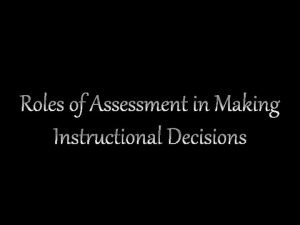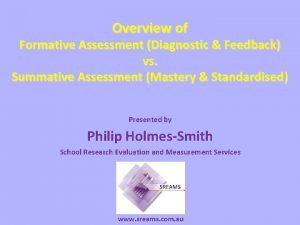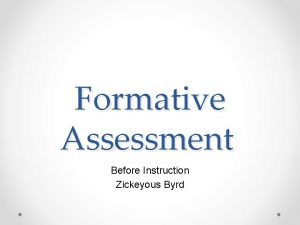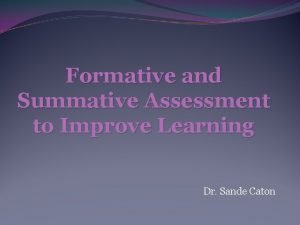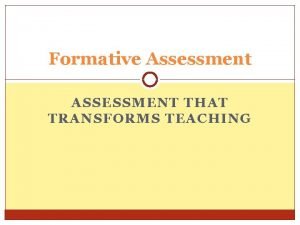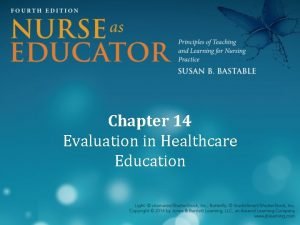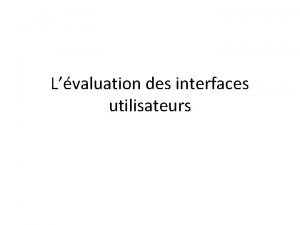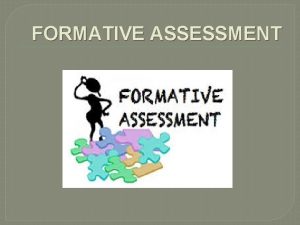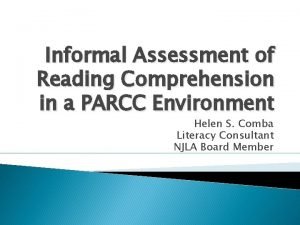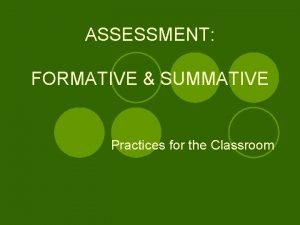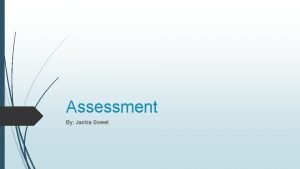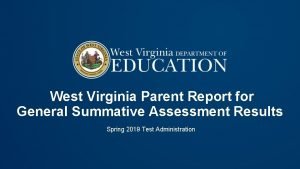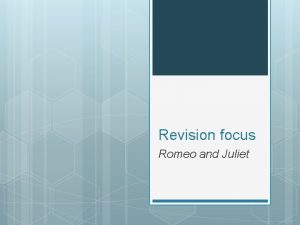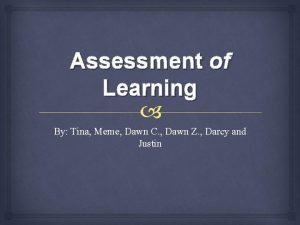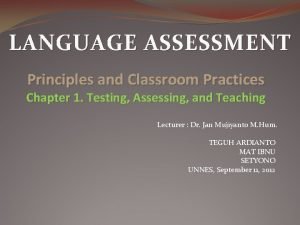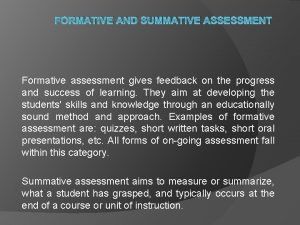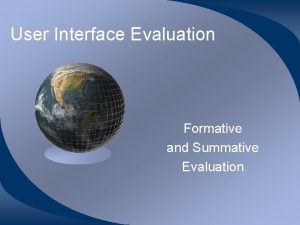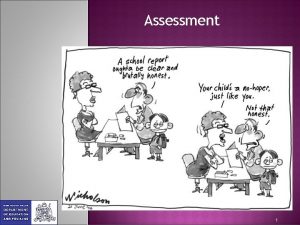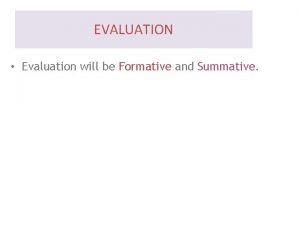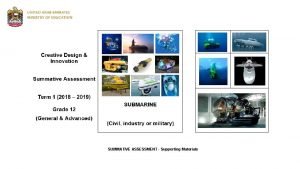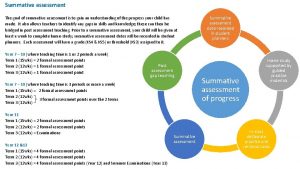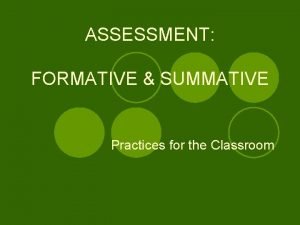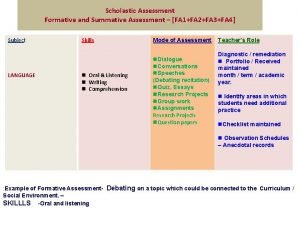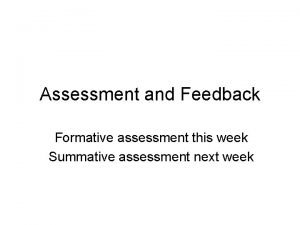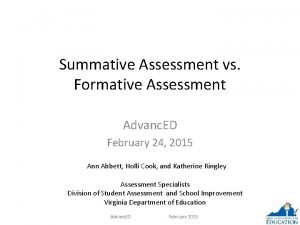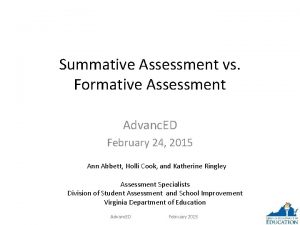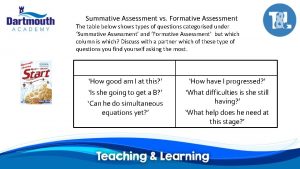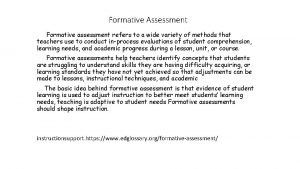1 Diagnostic Assessment 2 Formative Assessment 3 Summative

















- Slides: 17


1. Diagnostic Assessment 2. Formative Assessment 3. Summative Assessment

1. Diagnostic Assessment v Type of assessment that is normally undertaken before instruction in order to determine the students’ prior knowledge of a particular topic or lesson. v Its purpose is to anticipate potential learning problems and group/place students in the proper course or unit of study.

Diagnostic assessment evaluates: • what level of skills and knowledge the student has already achieved; • what skills and knowledge the students can bring with them into the course; • Any gaps or weaknesses that are apparent in the student’s knowledge compared to others of a similar age and ability; • any potential factors that may have an impact on how the students learn, and • any additional requirements that students may have in terms of differentiating learning and meeting learning needs.

Diagnostic assessment takes many forms, like: • interviewing the student; • discussion with parents/ carers/ other educational professionals who have close links to the students; • summative assessment of any previous work or test results; • subject-specific skills test or concept tests, and • close monitoring and tracking of pupil progression.

2. Formative Assessment v It is usually administered during the instructional process to provide feedback to students and teachers on how well the former are learning the lesson being taught. v It uses pretests, homework, seatwork, and classroom questions. Results of formative assessment are neither recorded nor graded but are used for modifying or adjusting instruction.

Characteristics of formative assessment: • Formative assessment informs the learning. • Happens continuously in a classroom environment. • Involves both teacher and learner in a process of continuous review and consideration regarding levels of progress. • Provides constructive and encouraging feedback, allowing individuals to take responsibility for their own learning. • Allows lesson plans to be assessed and adjusted as necessary, making teachers instantly aware of any potential problems or areas of difficulty. • Allows a teacher to plan lessons in line with their pupils’ abilities. • Is an exceptional asset to maintain effective and high quality teaching standards. • Can be oral or written feedback. • May take the form of positive assessment.

Formative assessment is used by: • • Checking to see if the whole class is sure about what has been asked of them. Engaging students through direct or ‘hands-up’ questioning. Walking around the classroom to monitor students’ progress. Guiding a student or whole class through a task through modeling in her teaching. Conscientious and up-to-date marking if work by pupils. Openly praising good work done in class. Reprimanding for poor behavior in the playground. Taking time to ask how a student is feeling – showing an interest in the student as a person not just as a learner.

Some negative points of formative assessment: • • • Danger of being too impulsive or improvised, and may not always provide an accurate degree of reliable objectivity. Can be damaging to pupils’ self esteem if not used appropriately or sensitively. Can be difficult to set and maintain rigid assessment standards if there is little or no ‘paper work’ to back it up. Can lose meaning and impetus if used too often or incorrectly. Can be imposing if the teacher guides the class too much often, or if the class relies on the teacher too much – ‘spoon feeding’. It can sometimes appear as if the teacher is favoring some students over others, especially if they commend or reprimand particular students more than others.

3. Summative Assessment v This type of assessment is undertaken to determine student achievement for grading purposes. v It is frequently based on cognitive knowledge, as expressed through test scores and written outputs. v Results of summative assessment can be utilized not only for judging student achievement but also the effectiveness of the teacher and the curriculum.

Characteristics of Summative Assessment • Summative assessment sums up the learning; • Carried out by both subject teacher and a board of external examiners; • Carried out at the end of the unit, semester, school year, or when the pupil is about to leave the school; • Makes judgments regarding the pupil’s progress and performance in relation to national standards; • Provides an overview of the pupil’s attainment at the end of crucial stages in their education; • Takes the form of a monitored test or exam and is more commonly written than oral; and • It can be used to monitor the performance of a whole school or group, not just an individual.

Drawbacks of summative assessment • • Attainment levels are rigid and not usually open to reviews; the grade achieved is irrefutable. Exams can only assess the pupil’s performance on that day, regardless of performance levels outside of the exam situations. Poor performance in an exam can make student’s excellent performance over the year seem pointless, lowering their opinion of the education system. Ranking and scaling pupils can be damaging to their self-esteem. National exams carry great stress and pressure that can be overwhelming for many students, consequently affecting their performance. Many students pin their future plans on gaining good grades in exams, poor results can mean their goals are irreparably shattered. School – based summative assessment is time – consuming and means a lot of work for the teacher to ensure it is completed to a high standard. Inexperienced teachers may find marking papers and tests difficult and may be too harsh or generous when awarding grades.

Two distinct assessment methods: • Normative Assessment • Criterion Assessment

Normative Assessment • Concerned with national and local targets and Local Education Authority guidelines • Assesses the progress of a student in relation to others of the same peer group, age or ability • May involve ranking or scaling a pupil to help with streaming classes • May look at cross-school achievements to compare achievement in particular groups, subjects and years with local and national levels of attainment

Criterion Assessment • Concerned with national examination and other assessment bodies • Used in the assessment of vocational and academic qualifications • Determines if a student can carry out a specific task or activity within a particular situation or context • Results are given on a pass/fail, competent/not competent basis • Results are conclusive and usually open to review.

Uses of Assessment in Classroom Instruction 1. Placement assessment determines student performance at the beginning of instruction 2. Formative assessment monitors learning progress during instruction. 3. Diagnostic assessment diagnoses learning progress during instruction. 4. Summative assessment determines student achievement at the end of instruction.

 Is diagnostic test a formative assessment
Is diagnostic test a formative assessment Formative summative and diagnostic evaluation
Formative summative and diagnostic evaluation Examples of formative assessment
Examples of formative assessment Formative assessment
Formative assessment Summative and formative assessment
Summative and formative assessment Difference between formative and summative assessment
Difference between formative and summative assessment What is summative evaluation in hci
What is summative evaluation in hci Formative assessment meaning
Formative assessment meaning What is formative assessment
What is formative assessment Formative vs summative
Formative vs summative Summative and subjective assessment
Summative and subjective assessment Wv general summative assessment
Wv general summative assessment Diberikan suatu fungsi dengan persamaan y=2x-√x
Diberikan suatu fungsi dengan persamaan y=2x-√x Summative and objective
Summative and objective Romeo and juliet summative assessment
Romeo and juliet summative assessment Summative assessment memes
Summative assessment memes Wv general summative assessment
Wv general summative assessment Language assessment: principles and classroom practices
Language assessment: principles and classroom practices
